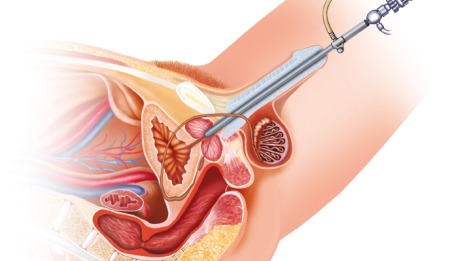 A cystoscopy is a procedure that allows a urologist to view the inside of the bladder and urethra. It is commonly recommended to evaluate urinary tract problems that cannot be identified through simpler testing such as urine analysis or IVP (Intravenous Pyelogram). More than just a diagnostic tool, the cystoscopy can also be used to treat small bladder stones, tumors, or bleeding and infection, thereby eliminating the need for more invasive surgery.
A cystoscopy is a procedure that allows a urologist to view the inside of the bladder and urethra. It is commonly recommended to evaluate urinary tract problems that cannot be identified through simpler testing such as urine analysis or IVP (Intravenous Pyelogram). More than just a diagnostic tool, the cystoscopy can also be used to treat small bladder stones, tumors, or bleeding and infection, thereby eliminating the need for more invasive surgery.
A cystoscopy can rule out many conditions, including:
- Inflammation of the urinary tract
- Abnormal tissue or cells
- Bleeding
- Narrow areas (strictures)
- Structural abnormalities
- Ulcers
- Stones
- Enlarged prostate gland in men
- Genital prolapse in women
The urologist will give you special instructions regarding your preparation for the cystoscopy, such as eliminating daily anticoagulants (aspirin, Plavix, Motrin, etc) for a short time and possibly adding antibiotics in advance if you have a heart valve murmur. These details are handled best when the physician is informed of your complete medical history and daily routine. A urine sample may be requested before the procedure to rule out an existing infection, the presence of which would necessitate postponing the procedure.
The cystoscope is a very narrow instrument with lenses, very much like a telescope or microscope. Usually the cystoscopy is done under general or local anesthesia to increase the patient’s comfort in the stirrup position while undergoing the insertion of the cystoscope and the sterile liquid (water or saline) used to fill the bladder for optimal examination. After the cystoscope is inserted into the opening of the urethra, an extension can be used to see the ureters which carry urine from the kidneys to the bladder. The entire procedure can last from a few minutes to possibly 30 minutes or more, depending on what needs to be accomplished.
After the test is finished, the patient may experience some mild burning with urination and even small amounts of blood in the urine. This would be considered normal in the first 24 hours. Drinking extra fluids will relieve these symptoms and help prevent urinary tract infection. If they continue longer or if there is severe bleeding or pain, the physician should be contacted. Antibiotics may be given as a preventative measure immediately following a cystoscopy for one or two days, and the physician should be contacted if pain, chills or fever develop as they may be signs of an infection that should be treated immediately.
Sometimes a diagnosis can be given immediately after the procedure. Typically, the results will be discussed at a follow up appointment, especially if a biopsy was taken.

